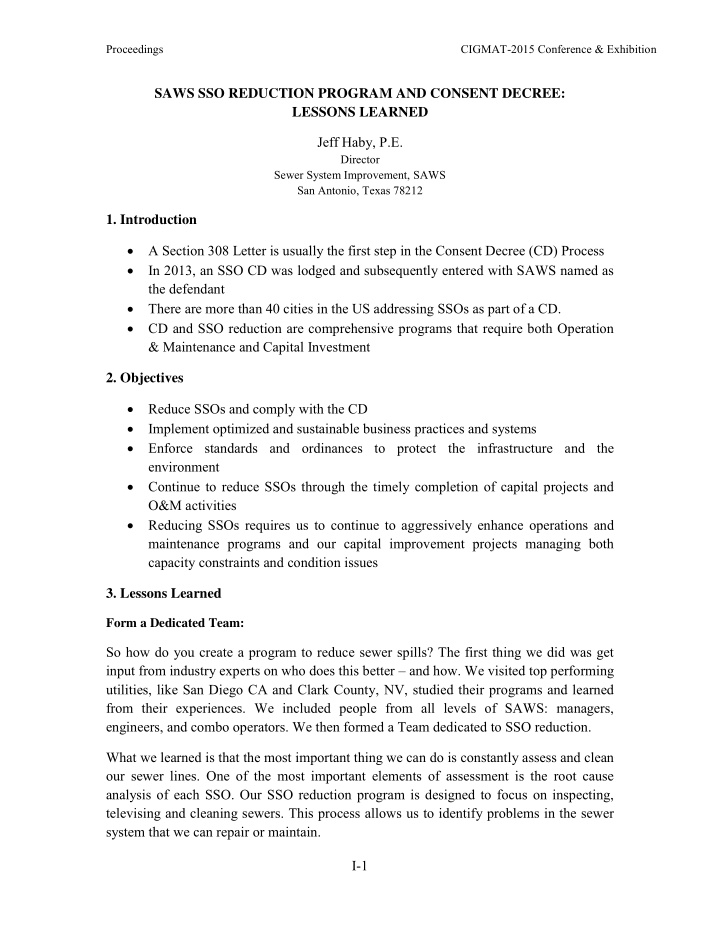



Proceedings CIGMAT-2015 Conference & Exhibition SAWS SSO REDUCTION PROGRAM AND CONSENT DECREE: LESSONS LEARNED Jeff Haby, P.E. Director Sewer System Improvement, SAWS San Antonio, Texas 78212 1. Introduction A Section 308 Letter is usually the first step in the Consent Decree (CD) Process In 2013, an SSO CD was lodged and subsequently entered with SAWS named as the defendant There are more than 40 cities in the US addressing SSOs as part of a CD. CD and SSO reduction are comprehensive programs that require both Operation & Maintenance and Capital Investment 2. Objectives Reduce SSOs and comply with the CD Implement optimized and sustainable business practices and systems Enforce standards and ordinances to protect the infrastructure and the environment Continue to reduce SSOs through the timely completion of capital projects and O&M activities Reducing SSOs requires us to continue to aggressively enhance operations and maintenance programs and our capital improvement projects managing both capacity constraints and condition issues 3. Lessons Learned Form a Dedicated Team: So how do you create a program to reduce sewer spills? The first thing we did was get input from industry experts on who does this better – and how. We visited top performing utilities, like San Diego CA and Clark County, NV, studied their programs and learned from their experiences. We included people from all levels of SAWS: managers, engineers, and combo operators. We then formed a Team dedicated to SSO reduction. What we learned is that the most important thing we can do is constantly assess and clean our sewer lines. One of the most important elements of assessment is the root cause analysis of each SSO. Our SSO reduction program is designed to focus on inspecting, televising and cleaning sewers. This process allows us to identify problems in the sewer system that we can repair or maintain. I-1
Proceedings CIGMAT-2015 Conference & Exhibition Develop Contracts for Support: Due to timeline requirement with most CDs you need to hit the ground running and enhance existing resources. This usually requires the development of a working load/staffing plan. The first part of the CD is mainly O&M/assessment which the second part is usually focused on fixing the issues identified using Capital Improvement Funds. Contracts included cleaning, CCTV inspection, point repairs, and a Program Manager. Reporting Requirement & Data Management The CD has numerous reporting requirements that include initial submittals (e.g. CMOM, SORP) along with weekly, monthly and annual reports. Document control and tracking is paramount. Capacity SAWS installed and manages data from 270 sewer flow meters throughout the system. We also have 35 rain gauges installed throughout the system. This data is being used to enhance the calibration of an existing hydraulic model. It also being used along with other field techniques to field verify capacity constraints. Field verification is a key component of the program. It helps to ensure that the capacity constraints being addressed are actually issues identified in the field. Fats, Oils and Grease Control Program (FOG) Cleaning, Enforcement and Education are all key elements for a successful FOG Program. Grease related SSOs are one of the highest causes of SSOs and the FOG Program should focus on known grease generators to reduce FOG from entering into your system. SAWS has implemented a tiered inspection program to allow more focus on known problem areas. Clean the Right Pipe at the Right Time SAWS is asset based and every pipe has its designated cleaning frequency (1, 3, 6, 12, 24 and 120 month) based on information obtained during cleaning operations. Removed material is evaluated and rated light, medium and heavy for grease, debris, and roots and se, debris, roots)y for ined during its designated cleaning frequency.ram Manager09 with the goal of reducing SSOs. Cleaning frequency are adjusted based on new data obtained. CCTV Inspection/Eliminating “Hot Spots” SAWS performs a “condition analysis” of each pipe after reviewing CCTV video. Focus resources on high risk pipe and areas of known issues. Assets are scored A through E based on the condition, with E being very poor, needs replacement because it has or is likely to cause an SSO. Based on this information each pipe then is placed in one of three I-2
Proceedings CIGMAT-2015 Conference & Exhibition buckets: maintain (through cleaning), monitor (CCTV Scheduled) and rehabilitation/replacement. Remedial Measures/Smart Cover Program Once a project is handed over to Engineering for rehab, ensure the asset(s) are still managed until construction occurs. SAWS uses Smart Covers to “babysit” assets awaiting design and construction or areas that have a known maintenance issues such as high grease areas. Smart Covers alarm when the water rises to a pre-determined level indicating an issue. SAWS then dispatches crews to investigate. Cost & Results The anticipated cost of the CD is $1.1.billion over the life of the CD (10 years). The programs developed and implemented have made a significant difference. SAWS has reduced SSOs 60% since 2010. In 2014 we were at 196 SSOs or 3.7 SSOs/100 miles of pipe. I-3
Recommend
More recommend